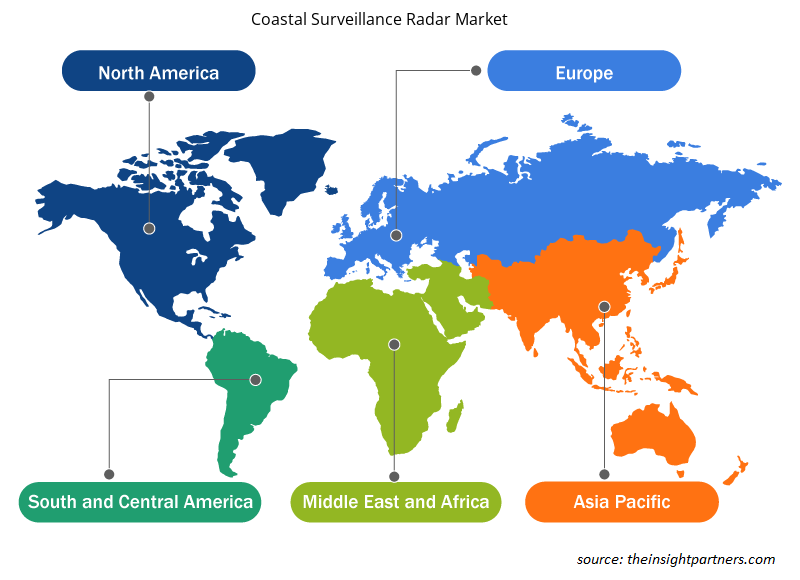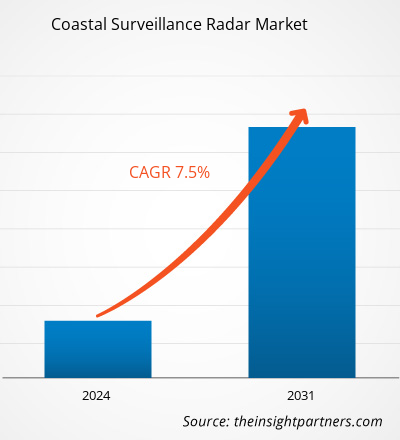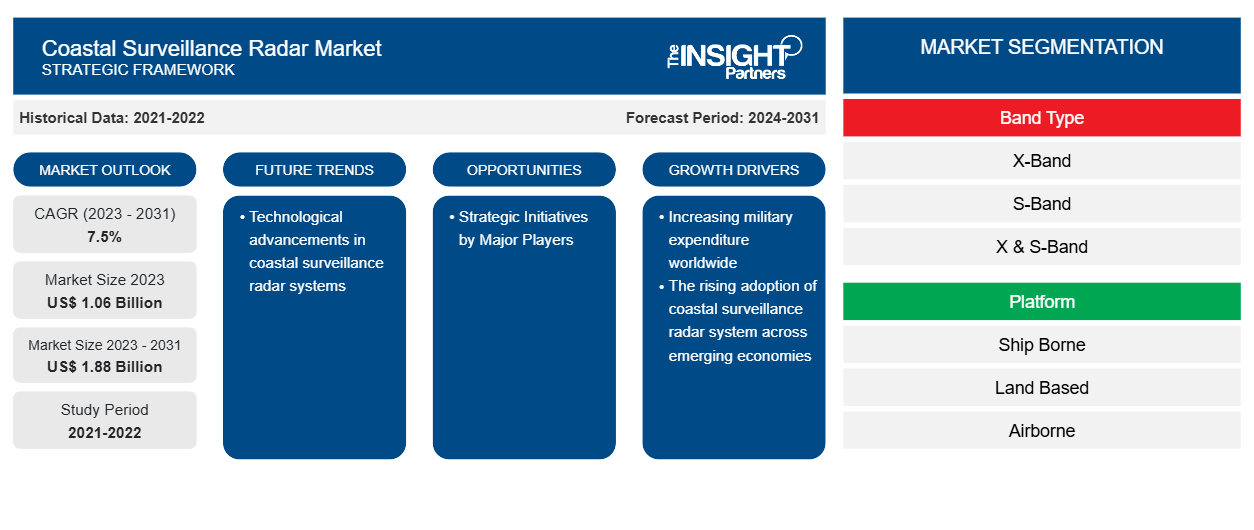해안 감시 레이더 시장 규모는 2023년 10억 6천만 달러에서 2031년 18억 8천만 달러로 성장할 것으로 예상됩니다. 이 시장은 2023~2031년 동안 7.5%의 CAGR을 기록할 것으로 예상됩니다. 해안 감시 레이더 시스템의 기술적 발전은 시장에서 핵심 트렌드로 남을 가능성이 높습니다.
해안 감시 레이더 시장 분석
Elbit Systems Ltd, Thales Group, Israel Aerospace Industries, Hensoldt AG, Terma A/S는 글로벌 해안 감시 레이더 시장에서 활동하는 주요 시장 참여자 중 일부입니다. 이러한 회사는 다양한 최종 사용자를 위해 X-밴드, S-밴드, X 및 S-밴드 레이더를 포함한 견고한 시스템을 개발하는 데 참여합니다. 또한 이러한 회사는 다양한 해군, 해안 경비대, 석유 및 가스 회사, 항구로부터 레이더에 대한 상당한 수의 계약을 누리고 있습니다. 이러한 회사는 해안 감시 레이더 제품 공급을 지원하기 위해 최종 사용자와 장기 계약을 체결하여 회사가 매년 수익을 창출할 수 있도록 합니다.
해안 감시 레이더 시장 개요
글로벌 해안 감시 레이더 시장 생태계의 주요 이해 관계자로는 구성 요소 제조업체, 시스템 통합업체, 최종 사용자 등이 있습니다. 해안 감시 시스템 레이더는 시스템 제조업체가 방대한 구성 요소 제조업체 기반에서 조달하는 다양한 구성 요소로 구성됩니다. 이러한 구성 요소 제조업체는 글로벌 해안 감시 레이더 플레이어에 기본 부품을 공급합니다. 시스템 통합업체는 각 구성 요소를 통합한 후 최종 감시 레이더 시스템을 제조하는 회사입니다. 글로벌 해안 감시 레이더 시장의 최종 사용자에는 해안선 전역에서 사업을 수행하는 관리 기관과 민간 조직이 모두 포함됩니다. 해안선에 있는 육상 다국적 석유 및 가스 회사는 운영과 자산의 안전과 보안을 보장하기 위해 감시 레이더에 크게 의존합니다. 반면, 선진국과 개발도상국의 군사 지출 증가와 마약 밀매, 테러, 불법 이민자 등의 요인으로 인해 육지와 해안 국경을 확실히 하기 위한 투자 증가도 정부 기관의 해안 감시 레이더 채택을 촉진하고 있습니다.
귀하의 요구 사항에 맞게 이 보고서를 사용자 정의하세요
이 보고서의 일부 또는 국가 수준 분석, Excel 데이터 팩을 포함하여 모든 보고서에 대한 사용자 정의를 무료로 받을 수 있으며 신생 기업 및 대학을 위한 훌륭한 혜택과 할인 혜택을 이용할 수 있습니다.
-
이 보고서의 주요 시장 동향을 알아보세요.이 무료 샘플에는 시장 동향부터 추정 및 예측까지 다양한 데이터 분석이 포함됩니다.
해안 감시 레이더 시장 동인 및 기회
신흥 경제권에서 해안 감시 레이더 시스템 도입 증가
중국, 인도, 대만, 한국, 러시아, 우크라이나, 이스라엘, 팔레스타인, 이란 등 신흥 경제권에서 국경 위협이 증가함에 따라 해안 감시 레이더 시스템 도입이 늘어날 것으로 예상됩니다. 해상 전쟁과 해양 반란이 증가함에 따라 이러한 경제권의 해안 지역은 점점 더 중요해지고 있으며 감시 레이더는 실시간으로 위협을 탐지하는 데 중요한 역할을 합니다. 지휘관은 해안 경계를 따라 고급 레이더 시스템을 배치하여 적의 움직임과 주변 환경에 대한 귀중한 통찰력을 얻을 수 있으며, 이를 통해 실시간 데이터를 기반으로 필요한 조치를 취할 수 있습니다. 선명하고 고해상도 이미지로 실시간 데이터를 수집하는 이러한 이점 은 최종 사용자에게 중요한 매력 포인트입니다. 따라서 중요한 매개변수를 바탕으로 해안 감시 레이더 시장은 전 세계적으로 성장해 왔습니다.
주요 기업의 전략적 이니셔티브
해안 감시 레이더 시장에서 활동하는 회사들은 높은 투자, 제품 제공, 글로벌 확장과 같은 유기적 및 무기적 성장 전략을 채택하고 있으며, 글로벌 해안 감시 레이더 시장의 성장 기회를 더욱 창출하고 있습니다. 언급할 몇 가지 주요 개발 사항은 다음과 같습니다.
- 2022년 9월, 미국 해안 경비대는 미노타우르 임무화 프로세스 동안 새로운 C-130J 슈퍼 허큘리스 장거리 감시 항공기에 설치될 최대 5개의 AN/APY-11 멀티모드 레이더에 대한 계약을 L3Harris Technologies Inc에 수주했습니다. 이 확정 고정 가격 계약은 3개의 멀티모드 레이더를 인도하기 위한 것이며, 이는 해안 경비대 함대의 18, 19, 20번째 C-130J 항공기에 대한 임무화 및 Block 8.1 업그레이드 동안 텍사스 와코에 있는 L-3 Communication Integrated Systems에서 설치할 것입니다.
- LIG넥스원은 2022년 12월 해군 물류 사령부와 해상 감시 레이더-II 프로젝트에 대한 계약을 체결했습니다.
이러한 발전은 다양한 지역의 시장 공급업체에게 새로운 기회를 창출해 왔습니다.
해안 감시 레이더 시장 보고서 세분화 분석
해안 감시 레이더 시장 분석에서 중요한 요소는 대역 유형, 플랫폼, 최종 사용자입니다.
- 밴드 유형에 따라 해안 감시 레이더 시장은 X-밴드, S-밴드, X/S-밴드 및 기타로 세분화됩니다. X-밴드 세그먼트는 2023년에 더 큰 시장 점유율을 차지했습니다.
- 플랫폼을 기준으로 해안 감시 레이더 시장은 선박 기반, 육상 기반, 항공 기반으로 세분화됩니다. 항공 세그먼트는 2023년에 더 큰 시장 점유율을 차지했습니다.
- 최종 사용자를 기준으로, 해안 감시 레이더 시장은 항구, 항구 석유 및 가스 회사, 해상 순찰 기관으로 세분화됩니다. 해상 순찰 기관 부문은 2023년에 더 큰 시장 점유율을 차지했습니다.
지역별 해안 감시 레이더 시장 점유율 분석
해안 감시 레이더 시장 보고서의 지리적 범위는 주로 북미, 유럽, 아시아 태평양, 중동 및 아프리카, 남미의 5개 지역으로 나뉩니다.
북미는 2023년 시장을 지배했고, 그 뒤를 유럽과 아시아 태평양 지역이 따랐습니다. 나아가 아시아 태평양 지역도 향후 몇 년 동안 가장 높은 CAGR을 보일 가능성이 높습니다. 미국은 북미 해안 감시 레이더 시장에서 가장 큰 시장 점유율을 차지했습니다. 미국은 또한 기술적으로 진보된 국가이며 수년에 걸쳐 새로운 기술을 도입할 엄청난 잠재력을 가지고 있습니다. 전국에 있는 석유 및 가스 회사도 해안선에서 운영을 보호하기 위한 기술을 도입할 엄청난 잠재력을 가지고 있습니다. 이는 전국의 불법 활동을 제한하거나 규제하기 위해 해안 감시 레이더를 도입하는 데 더욱 영향을 미치고 있습니다. Accipiter Radar Technologies Inc, Teledyne FLIR LLC, L3Harris Technologies Inc, Raytheon Technologies Corporation, SSR Engineering은 미국 시장에서 운영되는 일부 업체입니다.
해안 감시 레이더 시장 지역 통찰력
Insight Partners의 분석가들은 예측 기간 동안 해안 감시 레이더 시장에 영향을 미치는 지역적 추세와 요인을 철저히 설명했습니다. 이 섹션에서는 또한 북미, 유럽, 아시아 태평양, 중동 및 아프리카, 남미 및 중미의 해안 감시 레이더 시장 세그먼트와 지리에 대해서도 설명합니다.

- 해안 감시 레이더 시장을 위한 지역별 특정 데이터 얻기
해안 감시 레이더 시장 보고서 범위
| 보고서 속성 | 세부 |
|---|---|
| 2023년 시장 규모 | 10억 6천만 달러 |
| 2031년까지 시장 규모 | 18억 8천만 달러 |
| 글로벌 CAGR (2023-2031) | 7.5% |
| 역사적 데이터 | 2021-2022 |
| 예측 기간 | 2024-2031 |
| 다루는 세그먼트 |
밴드 유형별
|
| 포함된 지역 및 국가 |
북아메리카
|
| 시장 선도 기업 및 주요 회사 프로필 |
|
해안 감시 레이더 시장 참여자 밀도: 비즈니스 역학에 미치는 영향 이해
해안 감시 레이더 시장 시장은 소비자 선호도의 변화, 기술 발전, 제품의 이점에 대한 인식 증가와 같은 요인으로 인해 최종 사용자 수요가 증가함에 따라 빠르게 성장하고 있습니다. 수요가 증가함에 따라 기업은 제품을 확장하고, 소비자의 요구를 충족하기 위해 혁신하고, 새로운 트렌드를 활용하여 시장 성장을 더욱 촉진하고 있습니다.
시장 참여자 밀도는 특정 시장이나 산업 내에서 운영되는 회사나 기업의 분포를 말합니다. 주어진 시장 공간에 얼마나 많은 경쟁자(시장 참여자)가 존재하는지 그 규모나 총 시장 가치에 비해 나타냅니다.
해안 감시 레이더 시장에서 운영되는 주요 회사는 다음과 같습니다.
- Accipiter Radar Technologies Inc
- 아셀산 AS
- 블라이터 감시 시스템 유한회사
- 이샛 레이더 시스템 유한회사
- 엘비트 시스템 유한회사
- 텔레다인 FLIR LLC
면책 조항 : 위에 나열된 회사는 어떤 특별한 순서에 따라 순위가 매겨지지 않았습니다.

- 해안 감시 레이더 시장 주요 주요 업체 개요를 알아보세요
해안 감시 레이더 시장 뉴스 및 최근 개발
해안 감시 레이더 시장은 1차 및 2차 연구 이후의 정성적, 정량적 데이터를 수집하여 평가합니다. 여기에는 중요한 기업 간행물, 협회 데이터 및 데이터베이스가 포함됩니다. 해안 감시 레이더 시장의 몇 가지 개발 사항은 다음과 같습니다.
- Leonardo는 해상, 항공 및 육상 부문을 위한 소형 및 중형 3D 레이더, 전자 광학 센서 및 관성 시스템 생산을 전문으로 하는 이탈리아 회사인 GEM elettronica의 주식 자본 30%를 인수했습니다. (출처: Leonardo, 보도 자료, 2021년 4월)
- 센서 솔루션 제공업체 HENSOLDT가 미국 해안 경비대의 "Legend"급 National Security Cutter(NSC)에 검증된 TRS-3D 다중 모드 해군 레이더를 장착하고 있습니다. 미국 해안 경비대는 HENSOLDT에 약 1,000만 달러 상당의 후속 계약을 체결하여 최신 'Baseline D' 버전의 추가 레이더를 공급하고, 이 레이더는 캘리포니아 페탈루마에 있는 해안 경비대 훈련 센터(TRACEN)에 설치될 예정입니다. 지금까지 HENSOLDT는 미국 해안 경비대의 NSC 프로그램에 12개의 레이더를 공급했습니다. (출처: HENSOLDT, 보도 자료, 2023년 9월)
해안 감시 레이더 시장 보고서 범위 및 제공물
"해안 감시 레이더 시장 규모 및 예측(2021-2031)" 보고서는 아래 영역을 포괄하는 시장에 대한 자세한 분석을 제공합니다.
- 범위에 포함된 모든 주요 시장 세그먼트에 대한 글로벌, 지역 및 국가 수준의 해안 감시 레이더 시장 규모 및 예측
- 해안 감시 레이더 시장 동향 및 운전자, 제한 및 주요 기회와 같은 시장 역학
- 포터의 5가지 힘에 대한 자세한 분석
- 주요 시장 동향, 글로벌 및 지역 프레임워크, 주요 업체, 규정 및 최근 시장 개발 사항을 포괄하는 해안 감시 레이더 시장 분석
- 시장 집중도, 히트맵 분석, 유명 업체 및 해안 감시 레이더 시장의 최근 개발 사항을 다루는 산업 환경 및 경쟁 분석
- 자세한 회사 프로필
- 과거 분석(2년), 기준 연도, CAGR을 포함한 예측(7년)
- PEST 및 SWOT 분석
- 시장 규모 가치/거래량 - 글로벌, 지역, 국가
- 산업 및 경쟁 환경
- Excel 데이터세트
최근 보고서
관련 보고서
사용 후기
구매 이유
- 정보에 기반한 의사 결정
- 시장 역학 이해
- 경쟁 분석
- 고객 인사이트
- 시장 예측
- 위험 완화
- 전략 기획
- 투자 타당성 분석
- 신흥 시장 파악
- 마케팅 전략 강화
- 운영 효율성 향상
- 규제 동향에 발맞춰 대응























 무료 샘플 받기 - 해안 감시 레이더 시장
무료 샘플 받기 - 해안 감시 레이더 시장